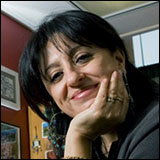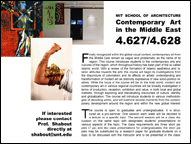Lecturer
(Visiting Faculty Spring 2008)
 |
Biography Nada Shabout was trained in architecture at the New York Institute of Technology, the University of Texas at Arlington and the Architectural Association School of Architecture , London, England. She has also earned BFA fine arts, MA and PhD in the Humanities with a concentration in art history and criticism from the University of Texas at Arlington, 1999. She wrote her dissertation on “Modern Arab Art and the Metamorphosis of the Arabic Letter.” A book based on her dissertation “Modern Arab Art: Formation of Arab Aesthetics,” was published by the University of Florida Press, 2007. She has been an Assistant Professor of Art History at the University of North Texas since 2002, teaching Arab visual culture and Islamic art. She has been working on the documentation of modern Iraqi heritage, particularly the collection previously held at the Iraqi Museum of Modern Art since her visit to Baghdad in June 2003. She has been organizing panels and presenting around the world on the state of Iraq’s modern heritage following 2003, the relationship of identity and visual representations in modern and contemporary Iraqi art, and exhibitions of Middle Eastern arts in the West since 911. Among her honors is The American Academic Research Institute in Iraq ( TAARII) fellowship 2006, 2007; and Fulbright Senior Scholar Program, 2007 Lecture/Research fellowship to Jordan Project, ” Arab Art Now: A Study of the Contemporary Art Vision in Jordan.” She is a founding member and first president (2007-2009) of the Association for Modern and Contemporary Art of the Arab world, Iran, and Turkey (AMCA). She is the curator of the traveling exhibition “Dafatir: Contemporary Iraqi Book Art,” 2005-07; and “Moments from 20th Century Iraqi Art,” at t he Montalvo Art Center , California, 2007- 2008 . She has edited the exhibition catalogue “Dafatir: Contemporary Iraqi Book Art (UNT Art Gallery, 2007). She is the author several articles that examine legal and ethical responsibilities of the US in Iraq after 2003, including, “The Iraqi Museum of Modern Art: Ethical Implications,” Collections ( Vol. 2, no. 4, May, AltaMira Press , 2006 ); “Historiographic Invisibilities: The Case of Contemporary Iraqi Art,” the International Journal of the Humanities (volume 3, Number 9, 2006); “The “Free” Art of Occupation: Images for a “New” Iraq,” Arab Studies Quarterly (Volume 28, Number 3 and 4 Summer and Fall 2006); and “Preservation of Iraqi Modern Heritage in the Aftermath of the US Invasion of 2003,” in Gail Levin and Elaine A. King, eds, An anthology on Ethics in the Art World (Allworth Press, 2006). |
